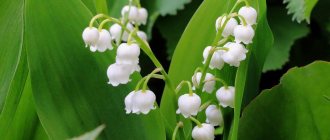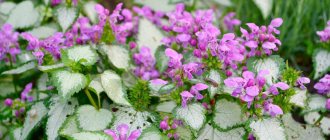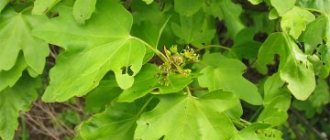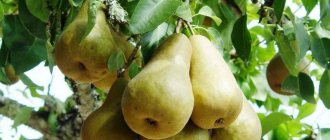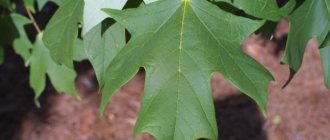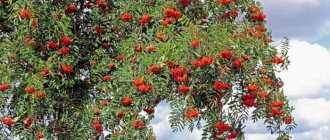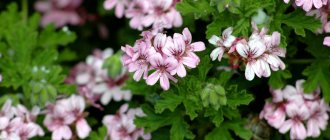Maple is a popular tree native to temperate zones of the southern and northern hemispheres. Widely distributed in North America along stream banks and beyond. In general, the genus of maples has about 150 species, among which black maple occupies a special place. This is a deciduous tree of unusual beauty, growing up to 40 meters in height.
A modest long-liver without a flaw
A detailed description of the Tatarian maple often begins with its habitat.
In its natural environment it is found in the following areas:
- Eastern and Central Europe;
- Asia Minor;
- Far Eastern part of Siberia.
The crop grows in deciduous forests, along river banks and along small slopes.
Its age reaches 100 years, and with careful care, the period increases by 2 times. Tatarian maple is a tree up to 12 m high, or a spreading multi-stemmed shrub. It is also called black maple because of the unusual color of the bark. The culture belongs to deciduous plants. The surface of its trunk and branches is covered with smooth gray-brown bark. There are many barely noticeable dark dents on it, which crack over time. Thin, slightly pubescent branches have raised scars and dark red buds. All of them are strewn with simple foliage, which is arranged in opposite order.
The edges of the plates can be solid or consist of 2-5 blades. They are oval or deltoid in shape. The length varies from 5 to 11 cm. The outer part of the leaf is colored rich green, and the back is slightly lighter. The veins are “decorated” with miniature fibers. In autumn, the plates acquire a fiery red hue, after which they “die” irrevocably.
In spring, white-green flowers with a scarlet tint appear among the lush greenery. The diameter of the buds is maximum 8 mm. They exude a fragrant aroma, so they attract many insects, including bees. The flowers are held on long petioles and collected in a lush corymbose panicle. The flowering period lasts about 2-3 weeks.
The fruits of the Tatarian maple are miniature lionfish. It consists of 2 halves, each 2 to 2.5 cm long. The plates are located at an acute angle and are painted green or deep red. In autumn they take on a brownish tone. Once fully ripe, the seeds remain on the tree throughout the season.
The plant blooms 14 days earlier than its “relatives”, but blooms later than everyone else.
"Twin Brothers"
Maple is a plant that is used for road and landscape landscaping. Breeders are working to develop new varieties. One of them is the Faassens black maple. In appearance, it can rightly be called the brother of black maple, only the variety is less tall and decorative. This species is often grown in vegetable gardens, parks, and squares.
Faassens Black has a dense, wide conical crown with large dark red-brown leaves. The tree reaches a height of no more than 15 meters. Further, in the process of growth, the crown develops evenly, reaching a diameter of 8 meters.
The leaves of the variety are large, richly colored, matte, on long petioles. When they bloom in the spring, they have a bright red hue. Along with the foliage blooming, the tree begins to bloom with greenish-yellow flowers. Then lionfish are formed, up to five centimeters long.
Features of the use of Tatar maple in landscape design
Tatarian maple is a deciduous tree that grows straight upward. Its appearance blends into the landscape but can be balanced by one or two finer or coarser trees or shrubs for an effective composition.
It is a relatively low-maintenance tree and is only pruned in the summer after the leaves have fully developed, as it "bleeds" sap if pruned in late winter or early spring. Does not have significant negative characteristics for human health.
Tartary maple is recommended for the following landscape applications:
- accentuation;
- mass planting;
- hill fortification;
- wind protection.
Tatarian maple leaves
Decorative and useful properties
Although the Tatarian maple is not very often used to decorate garden plots, it can still be found in parks and gardens, especially in European countries. Most often it is used to create hedges. Due to the bright color of the foliage in autumn, such plants are particularly attractive. Red unripe lionfish also add decorative value to the maple. Sometimes this tree is grown in bonsai form.
The tree has become more widespread in industry due to its beneficial properties. The bark of the plant is used for medicinal purposes, and the juice is made into a special syrup. It has many valuable properties, helping to improve immunity, preventing obesity, positively affecting the functioning of the gastrointestinal tract, strengthening blood vessels and protecting against periodontal disease. Dried bark and leaves, as well as seeds, are also used by traditional healers. They are included in drugs for pneumonia and even tuberculosis, and are also used to treat wounds. The healing properties of black maple were already known to the court doctors of Catherine II.
Along with these properties, the Tatarian maple can be used in the garden as a honey plant. Late flowering periods, occurring on warmer days, allow bees to collect more nectar from it than from other maple relatives. The honey obtained from the tree has excellent taste. It also carries considerable value and helps strengthen the nervous system and overall tone of the body, especially during the off-season. There is a positive effect of such honey on the organs of vision, digestion and cardiac activity. Maple syrup is produced in early spring. It is sweeter than birch. Both honey and syrup of this plant are used to create cosmetics that promote rejuvenation and restoration of the skin. The wood is used for industrial needs: it is suitable for creating furniture and finishing materials. It is also used to make musical instruments and small household items.
The antibacterial properties of the Tatarian maple make its branches a good raw material for bath brooms. They emit a pleasant aroma and promote relaxation, healing wounds and getting rid of toxins.
Interesting characteristics of Tatarian maple
Acer tataricum, or Tatarian maple, grows as a small upright tree with a dense, rounded crown or as a large multi-stemmed shrub. The plant is endemic to forested areas from Western Asia to Southeast Europe.
The bark is gray and rough. Lentils are ovoid or round. The branches are thin, pubescent. The buds are small in spring, 5-10 pairs per branch, with villous edges.
Mature trees produce broadly ovate, medium green leaves (up to 10 cm long) with jagged, double-breasted edges. Leaves on young trees are often 3-lobed.
The leaves turn yellow and red in autumn. In spring, greenish-white flowers appear in erect, long-flowered inflorescences. The flowers then grow into lionfish (up to 2cm long), which turn yellow/red in summer/autumn as they mature.
Medicinal properties of Tatarian maple
The Tatarian maple contains a huge amount of useful minerals and vitamins in its foliage and bark. Because of these beneficial substances for humans, black maple is often used in folk medicine. Syrup is made from maple sap, which is rich in vitamins and is considered an excellent remedy for vitamin deficiency and periodontal disease (scurvy).
Later, a more detailed study revealed other important characteristics of maple syrup. One of them was simply invaluable anti-obesity property. It also has a beneficial effect on the gastrointestinal tract. All infusions make blood vessels elastic and denser. They also strengthen the cardiovascular system.
Tatarian maple is a valuable honey plant. Honey from this plant retains all the healing properties of the tree itself. Maple honey has a magical effect on the immune system and strengthens the nervous system.
READ Scaly juniper: description of varieties
In addition to all the listed properties and qualities, black maple juice, its honey and syrup are used in cosmetic procedures. These bases are used to make lotions, lotions and baths to restore and rejuvenate the skin.
Also, dried raw materials from bark and leaves help against many diseases, including tuberculosis and pneumonia. Of course, these infusions and decoctions are used in complex therapy with many other drugs.
Chernoklen is famous for other medicinal properties. For example, from skin lesions. Heals trophic ulcers, heals wounds, preventing them from suppuration. To do this, the bark from a young maple is cut into thin strips and dried. And then they make decoctions and infusions, which are used to treat various diseases.
Of course, traditional medicine recipes have not been so popular for a long time, but the medicinal properties of the Tatar maple are remembered to this day. Perhaps this is what makes him one of the most beloved green inhabitants of our planet.
Juice
One of the healthiest maple products is its sap. First mentioned in the 16th century.
The beneficial properties of black maple are the benefits of the sap. Contains many vitamins, micro- and macroelements. Juice is 90% water. The juice contains many antioxidant compounds that are useful in the fight against cancer and pathologies of the cardiovascular system.
Maple sap contains little sugar, fructose, and glucose, so it is recommended for people suffering from diabetes and obesity.
Since ancient times, people have used not only maple sap, but also its leaves. Decoctions are prepared from them and used to treat diseases of the nasopharynx and skin pathologies. The effectiveness of the product is due to the antimicrobial effect of the resulting product.
Clen is considered a good antidepressant. Drinking juice helps reduce aggression, overcome stress, and restore energy. In some parts of Germany it is used as a potency enhancer.
There are no contraindications to taking the juice.
How to plant Tatarian maple on a plot
In order for the plant to take root in a new place, it is necessary to adhere to the agricultural technology of its cultivation. The same approach is applied to ornamental trees and shrubs. According to the diagram provided by experts, Tatarian maple is planted on the site in early spring or late autumn. The main condition is the ripening of the buds or the complete fall of leaves.
Seedlings are purchased in specialized stores or nurseries. The quality of specimens is determined by the root system and the appearance of the buds. They must be free of damage, dry areas and rot.
Since the plant loves plenty of sunlight, it is placed in open areas. As a last resort, plant in partial shade. However, under such conditions, the richness of the color of the foliage and inflorescences is lost. It is advisable that the sun shines on the Tatarian maple for at least half a day. Place it at a distance of 3-4 m from the fence, residential or commercial building. If you plan to create a green alley, then plant them at intervals of approximately 3 m.
In spring, the planting hole is prepared in advance so that the soil warms up properly. Its depth should be within 50-60 cm. And the width should be approximately 70-80 cm. The main thing is that the hole matches the size of the maple root system. If the site is dominated by clay soil and groundwater is close, use drainage.
Any of the materials will do:
- gravel;
- small crushed stone;
- pebbles;
- broken brick.
The thickness of the layer should be approximately 15-20 cm. In addition, the soil removed from the pit is mixed with humus, turf soil, sand and compost. If necessary, apply complex mineral fertilizers. Such a composition will significantly accelerate the development of culture. In a few years, the height of the Tatarian maple can reach two meters.
Next, the seedling is placed in the prepared funnel, trying to keep it in an upright position. The root system is carefully straightened so that the young seedling receives enough valuable components from the soil. The resulting space is filled with earth, which is gradually compacted.
If the Tatarian maple is planted to form a hedge, then the seedlings are placed from each other at a distance of 3-5 m.
Despite the unpretentiousness of the crop, immediately after planting, it needs abundant watering. 20 liters of water are poured under the young tree every day. When the top ball of earth dries out, it is thoroughly loosened. Thanks to this, the maple root system receives a sufficient amount of oxygen. To prevent moisture evaporation, the tree trunk surface is covered with mulch or peat. Over the next 3-4 years, the seedling is fed with mineral fertilizers.
Planting seedlings
As a rule, black maple is planted in the fall, after all the leaves have fallen, or in the spring before the leaves bloom. When seedlings are planted in groups, a distance of two to five meters is left between them.
The diameter of the planting hole should be about 80 cm, and the depth should be about half a meter. The maple root system grows more in breadth than in depth, so it is permissible to deepen the root neck by several centimeters.
If the area where you are going to plant a tree is subject to flooding, is swampy, or there is a high level of groundwater, drainage from sand, pebbles, screenings or crushed stone with a thickness of 10 cm to 20 cm is poured into the planting hole.
During planting, it would be a good idea to add rotted sawdust, manure or complex mineral fertilizers to the hole.
Landing tips
Source: books.google.com.ua
Tip 1. Select high-quality planting material and the right time
| |
Tip 2. Decide on a landing site and prepare a hole
| |
Tip 3. Plant the tree like this
| |
Tip 4. Water the seedling properly after planting
|
READ Cypress - stylish garden decoration
Folk remedies
The infusion is made from fresh maple leaves. To do this, you will need to grind the leaves, then pour a tablespoon of the raw material with a glass of boiling water and let it brew for thirty minutes. The resulting tincture is taken three times a day, dividing the resulting volume into equal parts.
You can make an alcohol tincture from maple. To prepare it, take a container into which maple leaves are placed. Then they are poured to the brim with vodka. The composition is infused for two weeks, after which it is filtered. Take twenty drops before meals.
To treat oral pathology, take a tablespoon of raw material and pour in 1.5 cups of boiling water. The resulting mixture is simmered over low heat for half an hour. The finished product is allowed to cool to room temperature. It is used as a mouth rinse three times a day.
Care Tips
Tip 1. Observe the frequency of watering in different seasons
| |
Tip 2. Fertilize the plant periodically
| |
Tip 3. Loosen the tree trunk circle
| |
Tip 4. Check your maple for diseases and pests
|
Reviews from gardeners
Steven58
For about 3 years, several maples have had some kind of fungal disease. Treated many times with copper containing substances. And the leaves were sprinkled on the ground in the circle around the trunk. There is almost no effect.
Source: www.forumhouse.ru
Tsvetaev
The trees are planted correctly, the roots are not buried. Agricultural technology is also in order: mulching, fertilizing, watering. But all maples get sick, it’s just that some are completely comatose, while others have a couple of branches drying out.
Source: websad.ru
Reproduction of Tatarian maple
To propagate the Tatarian maple, you can use its seeds. The plant begins to form them from 5-8 years of age. Sowing is carried out in the fall, after harvesting, or in the spring, but in this case the planting material will have to be stratified by keeping them in the refrigerator for 3-4 months. Before planting, the seed shell can be slightly sawed off and soaked in hot water for a day. Sowing is carried out superficially, only covering the seeds a little with soil and moistening them. Seed germination lasts for two years.
Care and attention to the plant
Everything that fills the earth points to the unsurpassed love of the Creator. People should treat their homesteads in the same way. When growing Tatarian maple in the country, it is important to follow the recommendations of experts. Otherwise, the plant will quickly dry out or lose its unique decorative effect. The young crop is watered once a week. Adult specimens need 20 liters of water once a month. During periods of drought, the dose and frequency of irrigation are increased by analyzing weather conditions. In case of heavy precipitation, watering should be stopped completely.
Trimming
In early spring and late autumn, the tree is subjected to sanitary pruning. First, it is carefully inspected, and then dry and damaged shoots are removed. The crown is formed in early summer. Thanks to this, the maple will look stylish and attractive, taking its place of honor in the summer cottage.
Insect attacks and preparation for winter
Unfortunately, this magnificent culture often suffers from pests. It is attacked by various sucking insects (aphids, scale insects, scale insects). Leaves are attacked by mites, caterpillars and sawflies. The gallworm lays larvae in the rhizome. The seeds are destroyed by beetles. In addition, even with decent care, maple can be affected by powdery mildew or necrosis. To rid a tree of disease, the foliage and branches are treated with chemicals that are freely sold in the store.
During the procedure, special protective equipment is used:
- long cloak;
- respirator;
- glasses;
- gloves;
- Rubber Shoes.
All fallen leaves are carefully raked and, if possible, burned. With the onset of the cold season, young seedlings need additional shelter.
For business use:
- sawdust;
- thick layer of mulch;
- regular burlap;
- dry leaves;
- coniferous spruce branches.
Any of these materials cover the near-trunk area of the plant. An adult Tatarian maple can withstand low temperatures and does not need human “support”. As you can see, the process of growing a crop consists of simple actions. First, choose a spacious open place. Dig a hole and fill the bottom with drainage. Next, carefully place the seedling and fill the space with soil. Care is carried out according to the generally accepted scheme.
Diseases and pests of Tatarian maple
The most common problem with black maple is coral spot. It affects the branches. Sometimes these are just spots on the bark, but often entire branches, or even the entire plant, die. Affected branches should definitely be cut out; this is precisely why sanitary pruning is needed. What is better is to remove all the branches and cover them with activated carbon and garden pitch.
You can also use copper sulfate. But this treatment is carried out by spraying in early spring, before the buds begin to open.
Powdery mildew often attacks black maple foliage, leaving it withered in unsightly spots. You can get rid of it by the same spraying, but with a soap and soda solution. The main thing is to ensure that the solution gets on both sides of the sheet.
Do not store medications; use the entire prepared volume of the substance at once. Later they lose their properties. Therefore, you do not need to prepare too much solution, and if this happens, use it all. If the problems have not disappeared, then re-treatment is required after three days.
In order for the plant to withstand winter frosts well, young seedlings can be covered with agrofibre or simply wrapped a couple of layers of burlap around the root collar of the plant. But even if the young plant is frozen, simply cut off the frostbitten stem.
Maple spot: treatment
Regardless of the type of spotting, there can be only one treatment - treating trees with fungicides. Fungicides are drugs that inhibit the vital activity of fungi.
All the drugs listed below work equally well in treating any spots. Therefore, when choosing, focus on the temperature outside the window. For example, “Bordeaux mixture” works if the temperature is +5...+22°C, and “Tiovit Jet” - in the range from -3 to +22°C. Check the temperature of action of the drug in the instructions on the package, strictly follow the consumption rate and precautions. List of fungicides.
They are systemic and contact. The difference between them is that systemic drugs are able to penetrate deep into the plant, while contact drugs remain on the surface.
- "SKOR"
- "HORUS"
- "PREVIKUR"
- ”ABIGA-PIK”
- ”TIOVIT JET”
- "TOPAZ"
- "BORDEAS LIQUID"
Treatment is an effective treatment, but the best treatment is prevention. The good news is that protecting a tree from disease is also quite simple. Let's look at the algorithm of actions.
Facts about Tatarian maple
In appearance, black maple resembles riverine maple. Some classifications even consider riverine one of its subspecies. Plants can be distinguished by the type of leaves: riverine maple has shiny leaf blades with more pronounced and deep lobes. Tatarian maple leaves are matte.
READ Lilac - planting and care, pruning and varieties. What is lilac - is it a bush or a tree?
In addition to landscaping, the tree is also used for field protection and reclamation plantings. Unlike field or Norway maples, it is more drought-resistant and salt-tolerant, therefore it is often used to create protective plantings in steppes and semi-deserts.
Purchasing healing black maple honey is not so easy: the tree blooms for a relatively short time, and besides, bees can simultaneously collect nectar from other plants. To avoid buying an expensive fake, you need to contact beekeepers or trusted suppliers. Black maple honey has its own differences: it is dark and thick, does not crystallize for a long time, and the taste is not too sweet, tart and quite spicy.
Contraindications for use
Like any other variety, black maple honey should not be consumed if you have certain medical conditions. The main contraindications are:
- the occurrence of allergic reactions to honey and bee products;
- individual intolerance;
- obesity in severe stages;
- exacerbation of stomach ulcers and pancreatitis;
- chronic diseases of the pancreas and liver;
- children's age up to three years.
Caution during use will not prevent women in the last stages of pregnancy and lactation (so as not to provoke allergies in the child), insulin-dependent (only under the supervision of a doctor) and people prone to gaining excess weight.
What does black maple look like?
What does black maple look like? The honey plant black maple, or otherwise Tatarian maple, is usually a low tree that can reach a height of 12 m or a large shrub, but as a rule, black maple in plantings reaches 4-5 meters in height. The black maple honey plant has smooth dark gray bark. Black maple leaves are oblong-ovate, three-lobed, doubly serrate along the edge. The color of the leaves is dark green above and light green below, the veins of black maple leaves are pubescent. In autumn, black maple leaves turn red or yellow. Black maple has white flowers that bloom after the leaves appear. Black maple begins to bloom at the age of 5-7 years. Bees willingly collect nectar from it - black maple honey. Black maple lionfish are initially pink or red in color, then become yellow-brown. Black maple seeds remain hanging on the tree for a long time, until frost sets in. Black maple seeds remain viable for 2 years. The root system of black maple is superficial and well developed, which allows it to bind the soil well on slopes. Black maple is a very drought-resistant plant, which is distinguished by its high salt tolerance compared to other types of maples. The honey plant black maple easily reproduces by seeds, root suckers, shoots, layering, and tolerates pruning well.
Description of the plant
The tree reaches a height of forty meters, and this species is a slow-growing one. The most intensive growth is observed in the first years of life, after which it slows down.
Black maple is a long-lived plant - it lives for more than two centuries.
This variety of maple is a non-flowering plant, with a growing season from early May to early October. It has a shallow root system.
Where does black maple grow?
The honey plant black maple grows over a vast area from the Balkans to the Ural River, reaching the city of Orenburg. The northern border of the distribution of black maple begins from the city of Tula and reaches in the south to the North Caucasus.
Black maple prefers to grow on fresh fertile chernozems; it grows well on clay or saline light chestnut soils. Black maple can grow even on the driest solonetzic and rocky soils.
Black maple is actively used for inclusion in forest shelterbelts, as well as for landscaping settlements. The black maple honey plant is distinguished by its drought resistance, being ahead of all other maples in this regard, and at the same time, the black maple plant is a frost-resistant plant and is not damaged by frost. It can tolerate frosts well in the steppes, with temperatures dropping to 30-40 degrees Celsius, and can be frost-resistant even in the Siberian climate. The black maple honey plant is a shade-tolerant crop that grows very well in height up to ten years of age. According to its biological characteristics, it grows well on the slopes of ravines, along ravines, in dry steppes and deserts. The black maple honey plant is actively used to create shelterbelts in the steppes, mixed with white acacia, honey locust, common elm and small-leaved elm. In protective forest plantations, black maple plays the role of soil-protective undergrowth. In such plantings, black maple is well renewed by self-seeding and shoots; the longevity of black maple plantings reaches 30-60 years. Black maple is a good submountain species for oak forest plantations. In protective afforestation, black maple can be used throughout the territory of the former USSR, in semi-desert, steppe and foothill zones. The black maple honey plant can be successfully used for landscaping populated areas, for creating edges, hedges, single and group plantings in parks; black maple suffers little from air pollution by gases, while releasing volatile fractions of phytoncides that have prostistocidal properties.
Growing conditions
The black maple tree and the similar Norway maple variety prefer to grow in light areas, but can easily tolerate partial shade, although in this case they slightly lose their attractiveness. Plants develop best in moist, fresh soils where there is no stagnant water. Knowing where the black maple grows, you can easily choose the right place. Ideally, for varieties with colored leaves, places with partial shade are selected.
To get a black maple like in the photo, cuttings are taken for propagation or grafting is done. The latter method is recommended for use only by an experienced gardener who has the skills to graft trees.
Black maple honey plant - Tatarian maple
Tatarian maple is a relatively low tree, common in deciduous and mixed forests.
The main collection from this honey plant in our country is carried out in the North Caucasus and Crimea. The flowering period begins early - in April-May and lasts no more than 3 weeks. This is exactly the time that bees are given to collect nectar and pollen from the maple tree. However, this collection is a labor-intensive process that requires skill and patience from beekeepers. It often happens that other plants bloom next to the maple, so beekeepers, in order to collect pure honey without impurities, try to track at what time different hives are filled. Maple blooms well and has the properties of a productive honey plant: from one hectare of planting you can get up to 150 kg of natural, very tasty honey.
Characteristics and scope of application
Maple is a favorite plant of landscape designers. It attracts with its elegance, spectacular openwork leaves with an unusual color. The barrel has a smooth surface with increased shine. It is actively used in the design of city parks, recreation areas, and garden plots.
- In addition to its decorative properties, maple is used in furniture production and construction.
- The most popular is Canadian maple, which boasts its high strength characteristics.
- The wood of this tree has excellent wear resistance and has a beautiful shade.
- Due to the numerous species of this tree, the hardness of the wood of each is different.
- Drying wood should not be fast and should not exceed 45 degrees Celsius, otherwise cracks will inevitably appear.
When processed, maple wood bends, glues, polishes, and is treated with dyes and antiseptics.
Certain types of maple are used to make musical instruments, interior items, kitchen utensils, and various crafts. The completed products do not deform, do not warp and last a long time.
The plant is also used in the food industry. Confectioners often use maple syrup when preparing desserts.
Maples in Russia
In Russia there are about 20 species of maples, 4 of them grow in the European part of the country (norway, Tatarian, white or pseudo-sycamore and field maples).
Blooming maple branch
Much more species grow in our Far East - small-leaf maple, river maple, false siebold maple, yellow maple, greenbark maple, Manchurian maple, Japanese maple maple, bearded maple maple, Chonoski maple maple, palm maple. All our European species grow in the Caucasus, as well as alpine maple, Montpelian maple, Colchis maple, and Sosnovsky maple. One species, Japanese maple, is even listed in the Red Book of Russia.
